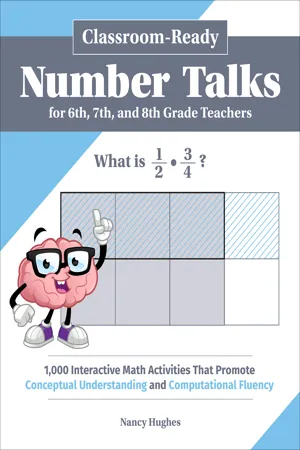
- 304 pages
- English
- ePUB (mobile friendly)
- Available on iOS & Android
Classroom-Ready Number Talks for Sixth, Seventh, and Eighth Grade Teachers
About This Book
The fun way to teach middle schoolers the mental math, problem-solving skills they need to meet common core standards and attain mathematical fluency. Bringing the exciting teaching method of number talks into your classroom has never been easier. Simply choose from the hundreds of great ideas in this book and get going, with no extra time wasted! From activities on multiplication and division to decimals and integers, Classroom-Ready Number Talks for Sixth, Seventh, and Eighth Grade Teachers includes:
- Grade-level specific strategies
- Number talk how-tos
- Visual and numerical examples
- Scaffolding suggestions
- Common core alignments
- Questions to build understanding
Reduce time spent lesson planning and preparing materials and enjoy more time engaging your students in learning important math concepts! These ready-to-use number talks are sure to foster a fresh and exciting learning environment in your classroom.
Frequently asked questions
Information
What Do You See?
Area and Perimeter 1
What do you see?

Area and Perimeter 2
What do you see?

Volume
What do you see?

Fair Shares 1
What do you see?

Table of contents
- Cover
- Title Page
- Introduction
- 1. What Do You See?
- 2. Addition Strategies
- 3. Subtraction Strategies
- 4. Multiplication Strategies
- 5. Division Strategies
- 6. Fraction Strategies
- 7. Decimal Strategies
- 8. Integer Strategies
- 9. Percent Strategies
- 10. Linear Equation Strategies
- Appendix
- Acknowledgments
- About the Author
- References
- Copyright